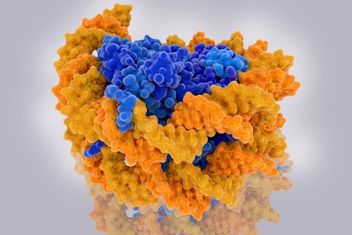Chromatin Immunoprecipitation (ChIP)
Chromatin immunoprecipitation, often referred to as just ChIP, is a form of immunoprecipitation that specifically investigates the interactions between proteins and DNA within a cell.
ChIP is a technique that is based on using antibodies to pull down or immunoprecipitate specific proteins and their associated DNA. DNA associated with a protein of interest is isolated and analyzed. Post-ChIP analysis of DNA is achieved by a number of methods, some of which include polymerase chain reaction (-PCR), microarray chip hybridization (-chip), and next generation sequencing (-seq).
See all ChIP Antibodies

Why Use ChIP?
ChIP has become a mainstream assay in genomics and epigenetics. It has been used extensively to identify DNA elements and proteins that regulate transcription and to study how histone modifications influence gene expression. The ability to analyze gene regulation and genome-wide epigenetic changes in human cancer and other diseases will lead to improved understanding of the role abnormal gene transcription plays in the development of disease. Furthermore, knowledge of the state of chromatin in this context will advance the development of valuable diagnostic tools and disease therapies.
When is ChIP used?
The use of ChIP as an assay technique is popular in the fields of genomics and epigenetics. It has been used extensively to identify DNA elements and proteins that regulate transcription and to study how histone modifications influence gene expression.
The ability to analyze gene regulation and genome-wide epigenetic changes in human cancer and other diseases will lead to improved understanding of the role abnormal gene transcription plays in the development of disease.
Furthermore, knowledge of the state of chromatin in this context will advance the development of valuable diagnostic tools and disease therapies.
The purpose of using ChIP is to identify the presence of a specific protein, or modified protein within a region of the genome.
How does ChIP work?
ChIP typically begins with live cells grown in culture. The cells are fixed with formaldehyde to crosslink proteins to their interacting DNA and the cells are lysed to release the proteins and associated DNA.
The DNA is sheared either by sonication or nuclease digestion and the antibody against a specific protein of interest is added. The antibody-protein-DNA immunocomplex is then isolated by adsorption to protein-A or -G agarose beads.
Immunoprecipitated DNA is eluted from the beads and the formaldehyde cross-links are reversed. After which the DNA is then extracted, precipitated, and solubilized for analysis by one of a number of methods.
The Different Forms of ChIP
There are a few different methods for analyzing immunoprecipitated DNA, such as the following types of different methods:
ChIP-PCR
This method examines DNA by PCR using primers specific to a gene. It is considered a biased analysis and must presume binding of factors to specific DNA sequences.
ChIP-chip
ChIP-chip, or "ChIP-on-chip", is a method that provides an unbiased survey of immunoprecipitated DNA via hybridization to whole genome microarrays. Enriched DNA is amplified and labeled with a fluorescent probe and hybridized to a microarray chip.
ChIP-seq
This method uses next generation sequencing to analyze DNA in an unbiased genome-wide manner. It was developed to overcome limitations of the ChIP-chip method.
Immunoprecipitated DNA fragments are sequenced, and enriched regions are compared with input reads and detected as "peaks." The enriched sequences are mapped back to the reference genome to provide sequences bound by the protein of interest.
ChIP FAQs
Chromatin immunoprecipitation (ChIP) is a technique that is used to investigate the interactions between proteins and the DNA they interact with. This technology uses antibodies which are responsible for recognizing and binding to target proteins.
In most cases of ChIP methodologies, proteins are crosslinked to the specific DNA target. The DNA-protein complex is then sheared from the remaining DNA, before the same target is isolated via immunoprecipitation.
ChIP can be used across many applications to investigate interactions between proteins and DNA within a cell.
By clicking “Acknowledge”, you consent to our website's use of cookies to give you the most relevant experience by remembering your preferences and to analyze our website traffic.
